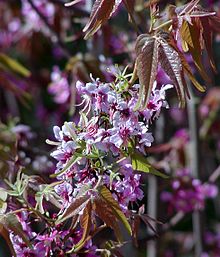
Pistacia is a genus of flowering plants in the cashew family, Anacardiaceae. It contains 10 to 20 species that are native to Africa and Eurasia from the Canary Islands, all of Africa, and southern Europe, warm and semidesert areas across Asia, and North America from Mexico to warm and semidesert United States, such as Texas or California.

Campsis radicans, the trumpet vine, yellow trumpet vine, or trumpet creeper, is a species of flowering plant in the family Bignoniaceae, native to eastern North America, and naturalized elsewhere. Growing to 10 metres, it is a vigorous, deciduous woody vine, notable for its showy trumpet-shaped flowers. It inhabits woodlands and riverbanks, and is also a popular garden plant.

The genus Aesculus, with species called buckeye and horse chestnut, comprises 13–19 species of flowering plants in the family Sapindaceae. They are trees and shrubs native to the temperate Northern Hemisphere, with six species native to North America and seven to 13 species native to Eurasia. Several hybrids occur. Aesculus exhibits a classical Arcto-Tertiary distribution.
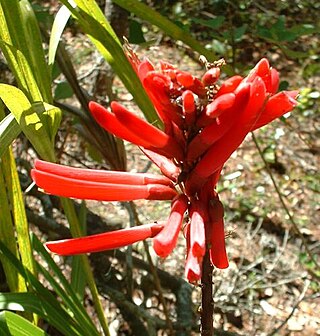
Erythrina herbacea, commonly known as the coral bean, Cherokee bean, Mamou plant in South Louisiana, red cardinal or cardinal spear, is a flowering shrub or small tree found throughout the southeastern United States and northeastern Mexico; it has also been reported from parts of Central America and, as an introduced species, from Pakistan. Various other systematic names have been used for this plant in the past, including Erythrina arborea, Erythrina hederifolia, Erythrina humilis, Erythrina rubicunda, Corallodendron herbaceum and Xyphanthus hederifolius.
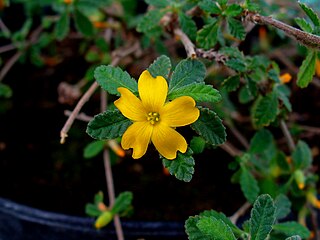
Turnera diffusa, known as damiana, is a shrub native to southern Texas in the United States, Central America, Mexico, South America, and the Caribbean. It belongs to the family Passifloraceae.
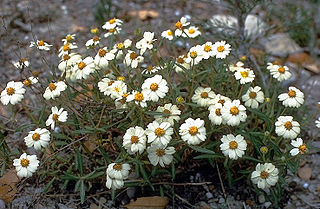
Melampodium is a genus of flowering plants in the sunflower family.

Parkinsonia, also Cercidium, is a genus of flowering plants in the pea family, Fabaceae. It contains about 12 species that are native to semi-desert regions of Africa and the Americas. The name of the genus honors English apothecary and botanist John Parkinson (1567–1650).
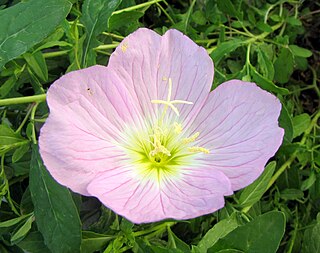
Oenothera speciosa is a species in the evening primrose family known by several common names, including pinkladies, pink evening primrose, showy evening primrose, Mexican primrose, and buttercups.

Chilopsis is a monotypic genus of flowering plants containing the single species Chilopsis linearis. It is known commonly as desert willow or desert-willow because of its willow-like leaves, but it is not a true willow – being instead a member of the catalpa family.

Leucaena is a genus of flowering plants in the mimosoid clade of the subfamily Caesalpinioideae of the family Fabaceae. It contains about 24 species of trees and shrubs, which are commonly known as leadtrees. They are native to the Americas, ranging from Texas in the United States south to Peru. The generic name is derived from the Greek word λευκός (leukos), meaning "white," referring to the flowers.

Dermatophyllum secundiflorum is a species of flowering shrub or small tree in the family Fabaceae that is native to the Southwestern United States and Mexico. Its common names include Texas mountain laurel, Texas mescalbean, frijolito, and frijolillo.

Astronium graveolens is a species of flowering tree in the cashew family, Anacardiaceae, that is native to Mexico, Central America, and South America as far south as Bolivia. Common names include glassywood, ronrón (Spanish), and aroeira (Portuguese). This plant is cited in Flora Brasiliensis by Carl Friedrich Philipp von Martius.

Leucophyllum frutescens is an evergreen shrub in the figwort family, Scrophulariaceae, native to the U.S. state of Texas, where it is the official "State Native Shrub of Texas", and to the states of Coahuila, Nuevo León, and Tamaulipas in northern Mexico. Although commonly known as Texas sage, it is not a true sage and is distinct from the genus Salvia. The species is also called Texas Ranger, Texas rain sage, cenizo, Texas silverleaf, Texas barometerbush, ash-bush, wild lilac, purple sage, senisa, cenicilla, palo cenizo, or hierba del cenizo.

Sideroxylon celastrinum is a species of flowering plant in the family Sapotaceae, that is native to Texas and Florida in the United States south through Central America to northern Venezuela and Colombia in South America. Common names include saffron plum and coma. It is a spiny shrub or small tree that reaches a height of 2–9 m (6.6–29.5 ft). The dark green leaves are alternate or fascicled at the nodes and oblanceolate to obovate. Greenish-white flowers are present from May to November and are followed by single-seeded, blue-black drupes.

Erythrostemon mexicanus, formerly Caesalpinia mexicana, is a species of plant in the genus Erythrostemon, within the pea family, Fabaceae. Common names include Mexican holdback, Mexican caesalpinia, and tabachín del monte. It is native to the extreme lower Rio Grande Valley of Texas and to parts of Mexico: in the northeast and further south along the Gulf coast as well as the Pacific coast in Nayarit, Jalisco, Colima, and a small portion of Sinaloa.

Guaiacum angustifolium is a species of flowering plant in the caltrop family, Zygophyllaceae. Common names include Texas guaiacum, Texas lignum-vitae, soapbush and huayacán. It is native to southern and western Texas in the United States and northern Mexico. The specific name is derived from the Latin angustus, meaning "narrow," and -folius, meaning "-leaved".

Ebenopsis ebano is a species of flowering plant in the family Fabaceae, that is native to the coastal plain of southern Texas in the United States and eastern Mexico. It is commonly known as Texas ebony or ebano.

Chiococca alba is a species of flowering plant in the coffee family (Rubiaceae) native to Florida and the extreme southern tip of Texas in the United States, Bermuda, Mexico, Central America, the Caribbean, the Galápagos, and tropical South America. Common names include David's milkberry, West Indian milkberry, cahinca and West Indian snowberry. The specific epithet, alba, means "white" in Latin and refers to the color of its fruits.
Esenbeckia runyonii is a species of flowering tree in the citrus family, Rutaceae, that is native to northeastern Mexico, with a small, disjunct population in the Lower Rio Grande Valley of Texas in the United States. Common names include Limoncillo and Runyon's Esenbeckia. The specific epithet honors Robert Runyon, a botanist and photographer from Brownsville, Texas, who collected the type specimen from a stand of four trees discovered by Harvey Stiles on the banks of Resaca del Rancho Viejo, Texas, in 1929. Conrad Vernon Morton of the Smithsonian Institution received the plant material and formally described the species in 1930. Some consider it a synonym of E. berlandieriBaill. ex Hemsl..

Quercus mohriana, commonly known as the Mohr oak, shin oak or scrub oak, is a North American evergreen shrub or small tree in the white oak group and is native to the south-central United States and north-central Mexico. The species epithet mohriana honors the pharmacist and botanist Charles Mohr of Alabama.
